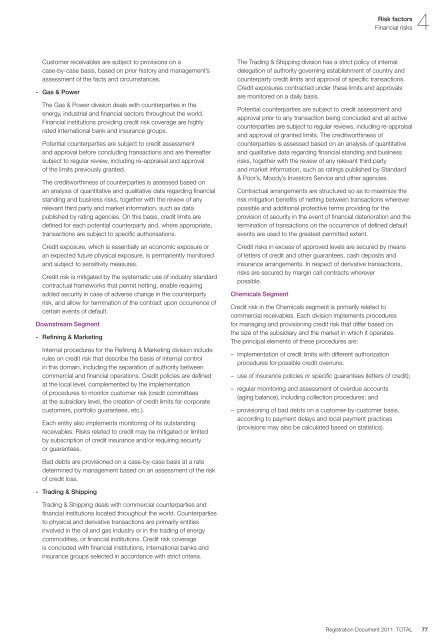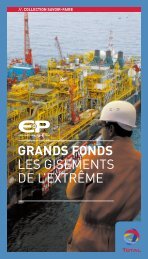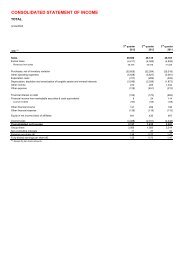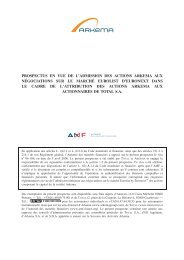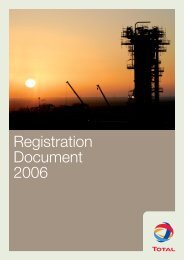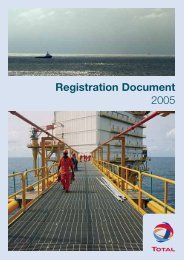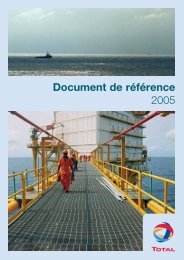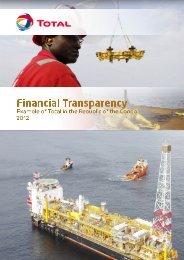Registration document 2011 - tota - Total.com
Registration document 2011 - tota - Total.com
Registration document 2011 - tota - Total.com
Create successful ePaper yourself
Turn your PDF publications into a flip-book with our unique Google optimized e-Paper software.
Customer receivables are subject to provisions on a<br />
case-by-case basis, based on prior history and management’s<br />
assessment of the facts and circumstances.<br />
- Gas & Power<br />
The Gas & Power division deals with counterparties in the<br />
energy, industrial and financial sectors throughout the world.<br />
Financial institutions providing credit risk coverage are highly<br />
rated international bank and insurance groups.<br />
Potential counterparties are subject to credit assessment<br />
and approval before concluding transactions and are thereafter<br />
subject to regular review, including re-appraisal and approval<br />
of the limits previously granted.<br />
The creditworthiness of counterparties is assessed based on<br />
an analysis of quantitative and qualitative data regarding financial<br />
standing and business risks, together with the review of any<br />
relevant third party and market information, such as data<br />
published by rating agencies. On this basis, credit limits are<br />
defined for each potential counterparty and, where appropriate,<br />
transactions are subject to specific authorisations.<br />
Credit exposure, which is essentially an economic exposure or<br />
an expected future physical exposure, is permanently monitored<br />
and subject to sensitivity measures.<br />
Credit risk is mitigated by the systematic use of industry standard<br />
contractual frameworks that permit netting, enable requiring<br />
added security in case of adverse change in the counterparty<br />
risk, and allow for termination of the contract upon occurrence of<br />
certain events of default.<br />
Downstream Segment<br />
- Refining & Marketing<br />
Internal procedures for the Refining & Marketing division include<br />
rules on credit risk that describe the basis of internal control<br />
in this domain, including the separation of authority between<br />
<strong>com</strong>mercial and financial operations. Credit policies are defined<br />
at the local level, <strong>com</strong>plemented by the implementation<br />
of procedures to monitor customer risk (credit <strong>com</strong>mittees<br />
at the subsidiary level, the creation of credit limits for corporate<br />
customers, portfolio guarantees, etc.).<br />
Each entity also implements monitoring of its outstanding<br />
receivables. Risks related to credit may be mitigated or limited<br />
by subscription of credit insurance and/or requiring security<br />
or guarantees.<br />
Bad debts are provisioned on a case-by-case basis at a rate<br />
determined by management based on an assessment of the risk<br />
of credit loss.<br />
- Trading & Shipping<br />
Trading & Shipping deals with <strong>com</strong>mercial counterparties and<br />
financial institutions located throughout the world. Counterparties<br />
to physical and derivative transactions are primarily entities<br />
involved in the oil and gas industry or in the trading of energy<br />
<strong>com</strong>modities, or financial institutions. Credit risk coverage<br />
is concluded with financial institutions, international banks and<br />
insurance groups selected in accordance with strict criteria.<br />
The Trading & Shipping division has a strict policy of internal<br />
delegation of authority governing establishment of country and<br />
counterparty credit limits and approval of specific transactions.<br />
Credit exposures contracted under these limits and approvals<br />
are monitored on a daily basis.<br />
Potential counterparties are subject to credit assessment and<br />
approval prior to any transaction being concluded and all active<br />
counterparties are subject to regular reviews, including re-appraisal<br />
and approval of granted limits. The creditworthiness of<br />
counterparties is assessed based on an analysis of quantitative<br />
and qualitative data regarding financial standing and business<br />
risks, together with the review of any relevant third party<br />
and market information, such as ratings published by Standard<br />
& Poor’s, Moody’s Investors Service and other agencies.<br />
Contractual arrangements are structured so as to maximize the<br />
risk mitigation benefits of netting between transactions wherever<br />
possible and additional protective terms providing for the<br />
provision of security in the event of financial deterioration and the<br />
termination of transactions on the occurrence of defined default<br />
events are used to the greatest permitted extent.<br />
Credit risks in excess of approved levels are secured by means<br />
of letters of credit and other guarantees, cash deposits and<br />
insurance arrangements. In respect of derivative transactions,<br />
risks are secured by margin call contracts wherever<br />
possible.<br />
Chemicals Segment<br />
Credit risk in the Chemicals segment is primarily related to<br />
<strong>com</strong>mercial receivables. Each division implements procedures<br />
for managing and provisioning credit risk that differ based on<br />
the size of the subsidiary and the market in which it operates.<br />
The principal elements of these procedures are:<br />
– implementation of credit limits with different authorization<br />
procedures for possible credit overruns;<br />
– use of insurance policies or specific guarantees (letters of credit);<br />
– regular monitoring and assessment of overdue accounts<br />
(aging balance), including collection procedures; and<br />
– provisioning of bad debts on a customer-by-customer basis,<br />
according to payment delays and local payment practices<br />
(provisions may also be calculated based on statistics).<br />
Risk factors 4<br />
Financial risks<br />
<strong>Registration</strong> Document <strong>2011</strong>. TOTAL 77


